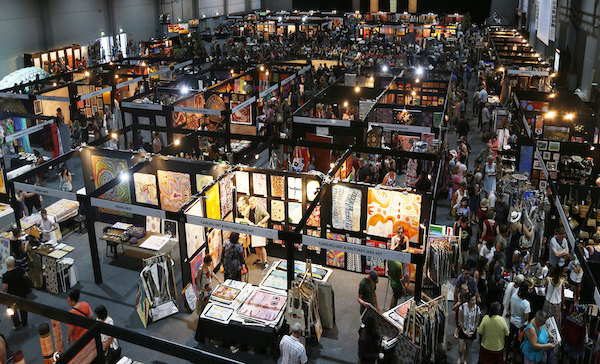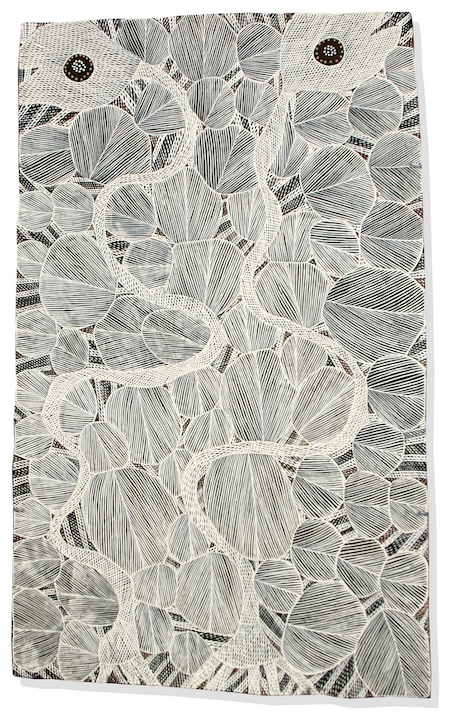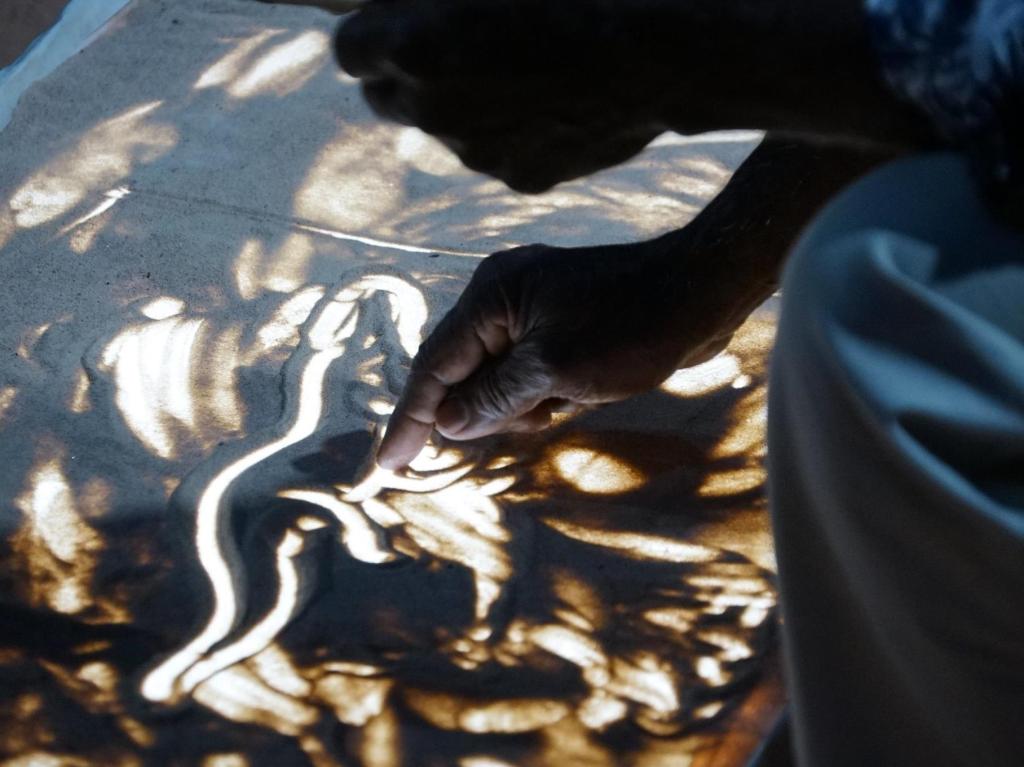Darwin Aboriginal Art Fair 2018, Sand Animation Workshop with Mervyn Street of Mangkaja Arts. Photo by Dylan Buckee.
For 13 years now, Darwin is transformed each August into the epicentre of Aboriginal and Torres Strait Islander culture, art, fashion, food and music. ‘These events are really dictating cultural excellence,’ DAAF Foundation Executive Director, Claire Summers told ArtsHub.
DAAF provides a rare opportunity for art lovers, collectors, curators and design aficionados to purchase art directly from Aboriginal and Torres Strait Islander owned and incorporated Art Centres.
‘What we really want is for people to understand the role that art centres play; it is paramount to what we do,’ Summers said. ‘By coming to DAAF you are actually supporting cultural self-determination in this country – it is as simple as that.’
Over 15,000 people are expected to visit Darwin over DAAF’s three-day run from 9-11 August 2019. ‘There is such a buzz on the ground; it’s a wonderful way to discover more about our Indigenous cultures.’
More than 2000 artists and designers will be in Darwin for DAAF.
‘We have an incredible array of new and emerging artists represented at the fair this year. There are over 70 art centres being represented, from Tasmania, to the Torres Strait Islands in the far north, to Geraldton in Western Australia,’ said Summers.
‘When you are buying at DAAF, you are buying from Australian Indigenous owned and operated art centres, so every time you spend it is going back into the development of those communities to be self-sustainable and self-empowered,’ she added.
Learn more about the DAAF 2019 program.
Complementing the art fair this year, the successful Melbourne fashion label Gorman has partnered with Mangkaja Arts Collection as part of the From Country to Couture fashion program.
Known for their collaborative approach, this is their first time Gorman has worked with an Indigenous community.

Darwin Aboriginal Art Fair 2018. Photo by Murray Hilton.
AN ART FAIR THAT TAKES NO COMMISSION
In 2018, DAAF generated more than $2.8 million in art sales. ‘This year we expect that figure to increase again,’ Summers said.
DAAF’s significant point of difference to most art fairs globally is that the organisers do not take a commission on sales.
‘Particularly when people still are having difficulty understanding the marketplace for Aboriginal and Torres Strait Islander art, you can be assured that what you buy at DAAF is ethically sourced, and that 100% of the money goes back to the community.’
Whether you are experiencing the art market for the first time to buy some gift cards or a t-shirt for $30,or growing your collection with a $30,000 painting by a leading artist, DAAF is open to all comers.
‘It has been quite ground breaking. They have worked to ensure the artists at Mangkaja Arts have agency from the design phase to the moment those patterns make their way to the textiles, and to the final garments’, explained Summers.

Malaluba Gumana, Garrimala (2019), Earth pigments on Stringybark, 1080 x 640mm. Courtesy the artist and Buku Larrŋgay Mulka.
Summers notes that Indigenous art fairs have gained considerable traction in the last decade.
‘DAAF is an incredible platform for them to connect with the industry in the broadest way beyond just the three days of the fair – it is about doing business,’ she told ArtsHub.
‘The significant thing about the art centre model is that they are often the only business that draws external income into the community. That money not only goes to the livelihood of artists, but also back into training opportunities within the community so that they can continue to preserve language and culture in those communities,’ she continued.
Summers knows the impact this can have first hand, having managed the Maningrida Arts & Culture in Arnhem Land for five years, and the Babbarra Women’s Centre, a cluster of seven micro-businesses supporting Indigenous women artists.
Tasked with creating and delivering the first Darwin Aboriginal Art Fair in 2007, and later appointed DAAF Foundation’s first Executive Director in 2016, Summers said the point of difference for DAAF – and its core vision – has always been to put Aboriginal and Torres Strait islander operated art centres at the forefront.
‘We don’t say no to an art centre wanting to participate – they are all welcome. We grow the fair to the need of community. It is about providing a vibrant cultural platform,’ she said.
‘Some of these art centres are from the most remote locations in the world, not just in Australia. The fair offers a bridge to allow everyone to come together and truly engage, and to learn from each other. We are serving a real need in the marketplace,’ Summers concluded.
WHEN TO VISIT 2019 DAAF
The 2019 Darwin Aboriginal Art Fair will be held at the Darwin Convention Centre.
Friday, 9 August 2019: 10am – 4pm
Saturday, 10 August 2019: 10am – 5pm
Sunday, 11 August 2019: 10am – 4pm





